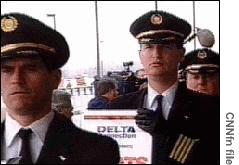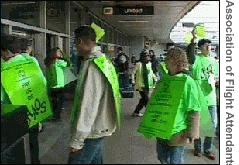|
Airlines hit by labor pains
|
 |
May 25, 2001: 6:51 p.m. ET
Even with some contracts behind it, tough talks loom for big 3 carriers
By Staff Writer Chris Isidore
|
NEW YORK (CNNfn) - No U.S. industry faces as great a threat from labor as the nation's airlines.
And as their passengers are learning, the carriers are not the only ones to feel the effects of the industry's labor pains.
Even though the industry has been spared a strike at one of its major carriers, the last 12 months have seen jets grounded by labor action by four different union groups at three of the nation's four largest carriers. The carriers all went to court to win injunctions to stop union members from grounding planes as a way of gaining leverage at the negotiating table.
A pilots strike at a feeder airline unit of Delta Air Lines has crippled the airline's second-largest hub in Cincinnati. And strike threats still loom at the big three carriers -- United Airlines, American Airlines and Delta, which between them carry more than half the nation's airline passengers.
| |

|
|
Pilots at Comair, a feeder airline subsidiary of Delta Air Lines, have been on strike since March 26. | |
Even though President Bush appears to stand ready to keep all three airlines' union members on the job, the unions have enough clout to win lucrative new contracts that are expected to raise the industry's overall labor costs by $2 billion this year, an amount that could equal or top the forecasted net income for the entire industry.
Still, even as Delta deals with the strike at its Comair unit, and American prepares for a possible strike this summer by its flight attendants, there are those who believe the worst of the industry's labor troubles are behind it.
"I think the rising risk from labor is hitting a ceiling," said Jim Higgins, analyst with Credit Suisse First Boston. "It doesn't lower the costs, but it reduces the risks getting there, as well as the risks of another significant increase in labor costs from the next contract."
Click here for summary of pending labor issues at major airlines
Part of the problem for the industry is that each union strives to achieve an "industry-leading" wage package for its members. Even when there is an agreement that brings doubled-digit percentage increases in wages, as the tentative agreement between Delta Air Lines (DAL: Research, Estimates) and its pilots union does, there are members who complain if the agreement is not seen as "industry-leading."
Employee-owned UAL Corp. (UAL: Research, Estimates), which owns United, is seen as setting the bar very high with its labor contract with its pilots last August, the first agreement in the current round of talks.
Now it faces difficult talks with the International Association of Machinists, which represents about 45,000 mechanics, ramp workers, customer service representatives and other employees, as well as a strike threat from its flight attendants, who threaten to strike even though they have an existing contract unless they are given an industry-leading contract before UAL closes on a proposed purchase of US Airways Group. United vowed to fight any strike by the flight attendants in court.
But management has leverage missing from most labor talks that the president can intervene and keep the union members working while a "presidential emergency board" that he appoints considers the dispute for 60 days. Following that 60-day period, Congress can act to impose the terms of a contract even if the rank and file union members don't like it.
President Bush used those powers to keep mechanics on the job at Northwest Airlines, the nation's fourth-largest carrier, earlier this year. It marked only the third time in more than 30 years such powers were used. It said it was necessary because he was worried about the impact of a major airline strike would have on a slowing U.S. economy.
Click here for a look at airline stocks
While he declined to use the powers to stop the pilots strike at Comair, his use of the PEB at Northwest and the threat of the a PEB at Delta itself is seen by analysts as helping to management to weather a year of labor discontent.
| |

|
|
Flight attendants at United hold an informational picket. | |
"We're seeing a situation where the president is willing to use the powers given to him, and I think we have a situation in Congress where they're willing to say enough is enough," said Higgins.
That threat may be enough to convince union negotiators and members to accept a contract that they would otherwise reject. One Delta pilot, who spoke on the condition his name not be used, said he's not satisfied with the tentative agreement reached by his union, but he's now leaning towards voting for it, and he believes about 60 percent of other members will as well, because of the threat of federal intervention.
"The guys are being told the negotiators worked very hard and this is best deal we can get under these circumstances," said the pilot, a former union official. "We're being told, 'If you reject this, you're looking at a presidential emergency board, and action by Congress.' Because of the way airline service has been, there isn't going to be a lot of sympathy for the pilots by members of Congress."
Still the big three airlines all face significant labor hurdles in the coming weeks and months, and analysts say that the uncertainty of those talks, and the final resolution of contracts, is enough to make them, and investors, nervous in the near-term.
"Not by any means is it all behind us," said Ray Neidl, analyst with ABN Amro. "It's going to be a constant spiral."
He said the talks that worry him the most involve pilots at American Airlines, a unit of AMR Corp. (AMR: Research, Estimates), which could start in August.
"They're going to want to top both Delta and United contracts and American needs relief over use of regional jets," Neidl said.
But before American even gets to that contract, they face a possible strike by its flight attendants, who are members of the Association of Professional Flight Attendants.
The National Mediation Board, which oversees labor relations in the airline and railroad industries, offered the union and management binding arbitration on May 23. While management accepted the offer, the APFA is not seen as likely to accept. If it does not, a 30-day cooling off period would start, which could open the door for a strike in late June or early July without presidential intervention.
The union has already seen membership reject a tentative contract agreement more than a year ago. The willingness of membership to vote down tentative agreements is one of the factors that so worries airline management.
"It is no longer a certainty that the membership will follow the recommendation of their leadership, which makes it very hard indeed to predict an outcome either way," said Donald Carty, the CEO of American parent AMR Corp., at its shareholder meeting earlier this month. 
|
|
|
AMR CEO sees turbulant times ahead - May 16, 2001
Vote puts strike at American on runway - Feb. 22, 2001
American flight attendants reject pact - Sept. 17, 1999
Comair vote hits Delta 2Q forecasts - May 14, 2001
Comair pilots to vote on settlement - May 4, 2001
Airline losses fly over 1Q forecasts - Apr. 18, 2001
Comair to slash jobs - Apr. 16, 2001
No end in sight for Delta feeder strike - Mar. 27, 2001
Delta feeder airline struck by pilots - Mar. 26, 2001
Pilots' leaders OK pact with Delta - May 3, 2001
Delta pilots questions threaten pact - May 2, 2001
Delta's pilots deal avoids strike - Apr. 23, 2001
Airline losses fly over 1Q forecasts - Apr. 18, 2001
Delta expects to report 1Q loss - Mar. 13, 2001
Airlines brace for labor cost hikes - Mar. 7, 2001
United flight attendants may strike - Apr. 3, 2001
|
|
|
|
|
|
 |

|

